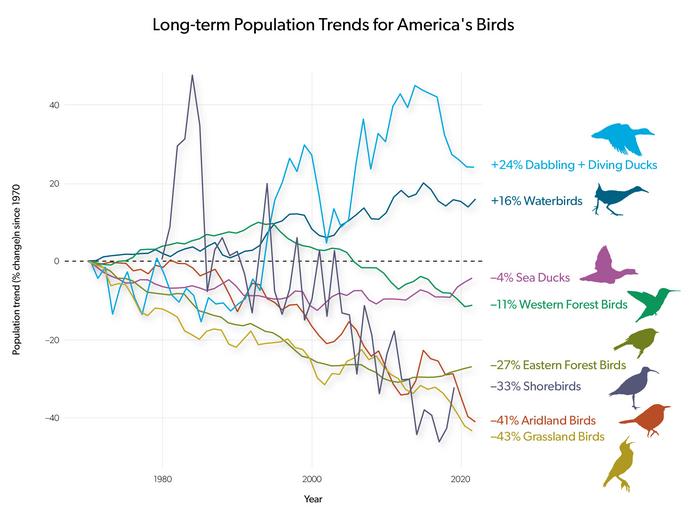The 2025 U.S. State of the Birds report has unveiled alarming trends that indicate a severe ongoing decline in American bird populations across various habitats. Released during the 90th annual North American Wildlife and Natural Resources Conference held in Louisville, Kentucky, the report—a collaborative effort by a coalition of prominent science and conservation organizations—raises urgent concerns regarding biodiversity and ecological health. As the report indicates, approximately 229 species of birds now demand immediate conservation measures, echoing previous findings that revealed a staggering loss of 3 billion birds in North America over the last five decades.
The enormity of the crisis is highlighted by key statistics indicating that over one-third of bird species in the United States are classified as being of high or moderate conservation concern. This situation includes 112 species identified as "Tipping Point," which have experienced a population decline exceeding 50% during the past 50 years. Red-alert species, such as Allen’s Hummingbird, Tricolored Blackbird, and Saltmarsh Sparrow, are particularly vulnerable and stand at the precipice of extinction without swift and strategic intervention.
The implications of the declines extend beyond the avian realm, as countless studies reveal that preserving bird populations parallels broader environmental health. According to the report, nearly 100 million people in the United States actively participate in birding activities, which substantially contribute to local and state economies. Recent data from the 2022 National Survey of Fishing, Hunting, and Wildlife-Associated Recreation flags that expenditures related to bird-watching represent total economic output of approximately $279 billion, supporting around 1.4 million jobs across various sectors. This remarkable financial impact underscores the interconnectedness of species conservation and economic vitality.
Bird populations are suffering across nearly all habitats, dismantling earlier notions that certain species, particularly ducks, were experiencing growth. In recent years, even historically stable duck populations have started trending downward. This alarming shift signals a broader environmental crisis, exacerbated by habitat loss, increasing environmental degradation, and the ever-looming threat of extreme weather events—a direct consequence of climate change.
Marshall Johnson, chief conservation officer at the National Audubon Society, proclaims that birds serve as ecological barometers, reflecting the urgent issues facing wildlife and human societies alike amid escalating environmental stressors. Furthermore, Dr. Amanda Rodewald from the Cornell Lab of Ornithology’s Center for Avian Population Studies emphatically states that birds are not mere indicators but represent an integral aspect of holistic human well-being. Declines in bird populations may symbolize deteriorating environmental conditions that threaten to undermine not just biodiversity but also human health.
The report’s findings stir a complex interplay of alarm and optimism, as highlighted by Jeff Walters, conservation committee co-chair at the American Ornithological Society. He asserts that the growing public interest in avian life and the economic benefits stemming from bird-watching are at unprecedented levels. Simultaneously, abundant information regarding the status of bird populations is now available, paving the way for possible recovery efforts rooted in science and collaborative strategies.
Beyond the immediate concerns regarding avian populations, the report also emphasizes the invaluable mental health benefits associated with bird observation and nature engagement. Interactions with wildlife, particularly birds, have shown to exert significant positive effects on human well-being—mitigating issues related to stress, anxiety, and depression. This revelation positions bird conservation not only as an environmental imperative but as a critical component of public health strategy.
Despite the troubling trends presented in the report, there remains a sense of hope driven by evidence indicating that conservation strategies have the potential for substantial success when adequately supported. As articulated by Dr. Steve Adair, chief scientist at Ducks Unlimited, the blueprint for successful conservation involves strategic planning and collaborative habitat restoration efforts. Established private land programs and partnerships aimed at conservation ranching, coastal restoration, and forest renewal exemplify how concerted action can reverse decline trends and facilitate ecological recovery.
The narrative of conservation and habitat protection extends beyond birds, as safeguarding their environments equally preserves crucial ecosystem services that support human survival. Habitat protection is a mutually beneficial endeavor that fosters a healthier planet not only for birds but for all life forms that depend on the Earth’s complex web of ecological interactions. Such multifaceted benefits emphasize that the stakes of conservation extend to the survival of humanity itself.
Michael J. Parr, the president of the American Bird Conservancy, reinforces the idea that although bird populations are experiencing severe challenges, tangible strategies exist to reverse declines. The paramount requirement remains adequate funding and commitment to conservation initiatives that account for the increasing threats faced by avian species. The science is clear: well-informed, well-executed conservation practices wield substantial power to heal relationships between nature and society.
Calls for action echo through the report, illustrating the unifying power of birds as agents of awareness and change. The commitment to safeguarding avian populations transcends geographic and political divides, illustrating that collective action is essential in conservation efforts. The responsibility lies with all stakeholders to advocate for the protection of birds today and future generations, recognizing their role in sustaining biodiversity and ecological balance.
In summation, the 2025 U.S. State of the Birds report serves as both a wake-up call and a rallying point for conservationists, policymakers, and the general public, underscoring the urgent need for comprehensive strategies aimed at reversing declines in bird populations. As this report demonstrates, the fate of birds is intricately tied to the health of our ecosystems and, ultimately, our own survival.
Subject of Research: Animals
Article Title: Alarming Declines in American Bird Populations Detailed in 2025 U.S. State of the Birds Report
News Publication Date: March 20, 2025
Web References: State of the Birds
References: NA
Image Credits: Credit: State of the Birds long-term population trends, courtesy of the Cornell Lab of Ornithology.
Keywords: biodiversity, bird conservation, ecological health, avian populations, environmental degradation, habitat loss, conservation strategy, economic impact.




